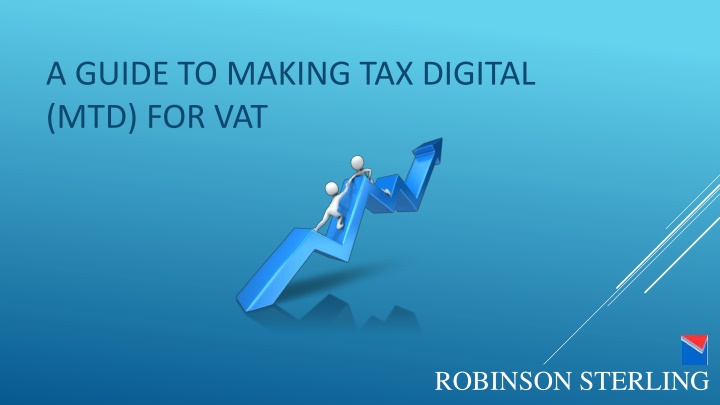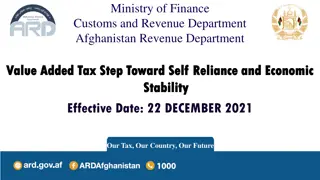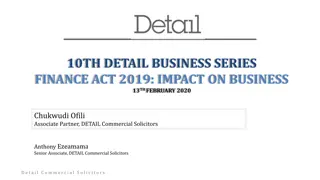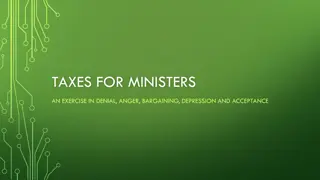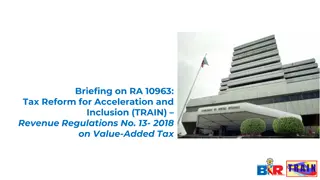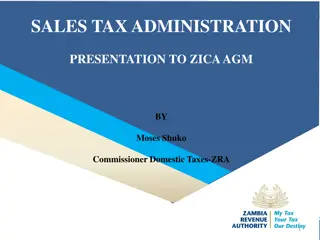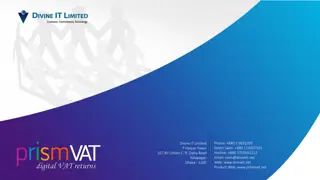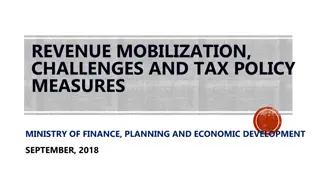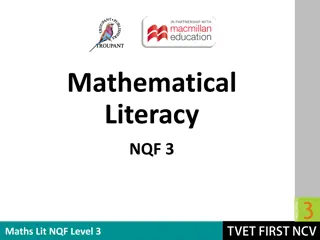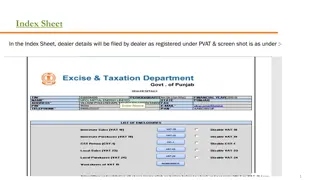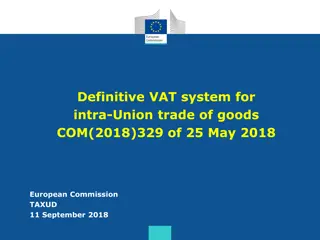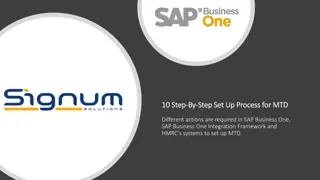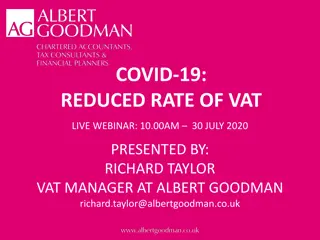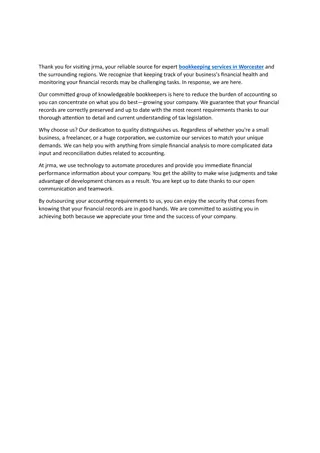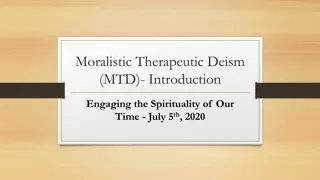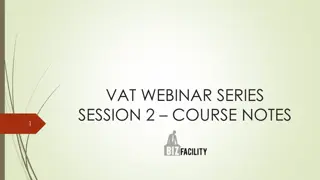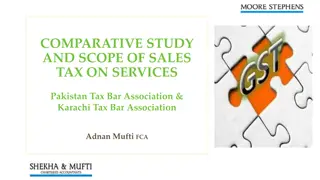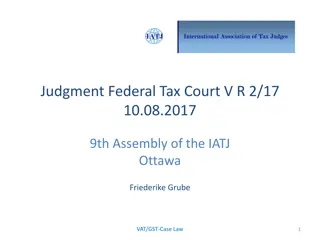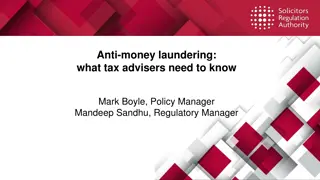A Guide to Making Tax Digital (MTD) for VAT Regulations
The new Making Tax Digital (MTD) for VAT regulations came into effect from April 1, 2019. Businesses with a taxable turnover over £85,000 must keep digital records and file VAT returns using HMRC-approved software. The Government Gateway for VAT returns will be disabled, and businesses need to register with HMRC for MTD. Certain complex businesses have a deferral option until October 2019. Options for compliance include using MTD-approved software, involving accountants, or cloud-based arrangements.
Download Presentation

Please find below an Image/Link to download the presentation.
The content on the website is provided AS IS for your information and personal use only. It may not be sold, licensed, or shared on other websites without obtaining consent from the author.If you encounter any issues during the download, it is possible that the publisher has removed the file from their server.
You are allowed to download the files provided on this website for personal or commercial use, subject to the condition that they are used lawfully. All files are the property of their respective owners.
The content on the website is provided AS IS for your information and personal use only. It may not be sold, licensed, or shared on other websites without obtaining consent from the author.
E N D
Presentation Transcript
A GUIDE TO MAKING TAX DIGITAL (MTD) FOR VAT ROBINSON STERLING
Summary of the new MTD regulations (1) The new regulations for MTD for VAT apply from the first VAT period (quarter) of a business commencing on or after 1 April 2019. MTD for VAT requires VAT registered businesses with a taxable turnover exceeding the VAT registration threshold of 85,000 to keep records in a digital format and file their returns using HMRC approved software. The software to be used must be capable of: Maintaining the trading and financial records of the business. Preparing the business VAT Returns from the information in those digital records, and Communicating with HMRC digitally via their Application Programming Interface (API) platform ROBINSON STERLING
Summary of the new MTD regulations (2) The Government Gateway used by VAT registered businesses for filing their VAT Returns will be disabled on or after 1 April 2019, VAT registered businesses will have to register with the HMRC, effectively informing them that they wish to use the MTD for VAT service and also date of their next VAT period (quarter). Having completed the registration for MTD, the VAT registered business will then have to comply with the new regulations from that date. Once a business has registered for MTD for VAT, it will be required to follow the new regulations even if taxable turnover of the business falls below the 85,000 VAT registration threshold. The only option available to the business to come out of the MTD regulations would be to de-register for VAT. ROBINSON STERLING
Summary of the new MTD regulations (3) Certain complex businesses may defer the start date for compliance with the MTD for VAT regulations by six months to 1 October 2019. These businesses must fall into one of these categories: Trusts. Not for profit organisations that are not set up as a limited company. VAT divisions. VAT groups. Public sector entities required to provide additional information on their Vat returns, such as Government Departments and NHS Trusts. Local Authorities. Public Corporations. Traders based overseas. Those required to make payments on account. Annual accounting scheme users. ROBINSON STERLING
Options available for businesses to comply with MTD for VAT 1. Purchase the full MTD approved software package and deal with the digital record keeping and the filing of the business VAT returns using this software. 2. Vat registered businesses can pass their records to their accountants, who will use their firm s MTD for VAT approved software to record the transactions digitally and file the VAT return on behalf of the business. 3. VAT registered businesses could also record their quarterly trading transactions in an Excel spreadsheet and email this to their accountants, who will then use approved MTD for VAT bridging software in order to file the business VAT return with the HMRC. 4. VAT registered businesses could use also set up a cloud-based arrangement and provide remote access to their accountants so that the business VAT return can be checked and agreed before submission by the business to the HMRC. N.B: This option would show that the business has taken reasonable care to prevent any errors and omissions for its VAT return, and could be very useful when it comes to either mitigating or removing VAT penalties. ROBINSON STERLING
Digital record keeping under MTD for VAT (1) 1. Permanent data such as the name of the registered business, VAT Number and any scheme used must be on the digital record. 2. All business sales need to be recorded separately into the MTD approved software or digital record. The batching of sales to make a single entry into the digital record will not be acceptable. 3. Similarly, all invoices for businesses purchases and expenses need to be recorded separately into the MTD approved software or digital record. The batching of purchases and/or expenses invoices to make a single entry into the digital record will not be acceptable. 4. The key transaction data to be digitally recorded for each Sales, Purchases and Expenses invoice is as follows: Time of supply (Tax Point). Value of supply (Net value excluding VAT). Rate of VAT charged. ROBINSON STERLING
Digital record keeping under MTD for VAT (2) 5. Retailers must record daily gross takings, but there is no need to digitally record each transaction within a day. Daily Z Total printouts and till receipts should be retained to back up the daily gross takings total. 6. For all VAT registered businesses using the Flat Rate Scheme, only purchases invoices for capital goods costing more than 2,000 will have to be digitally recorded under the MTD regulations. 7. The deadlines for the submission of VAT returns under the MTD regulations will remain unchanged. However, there will be no requirement to change VAT quarter dates to align with the tax / accounting year-end. 8. Our advice for all businesses, whose VAT Return quarters are ending on or before 31 March 2019, is to register for MTD for VAT after the submission of this VAT return. ROBINSON STERLING
Major software products on the market (1) There are a number of software providers in the market who have developed both main and bridging software for MTD for VAT. For your main software for MTD for VAT, you could consider: Sage more details on https://www.sage.com/en-gb/making-tax-digital/ 1. Xero more details on https://www.xero.com/uk/resources/making-tax-digital/ 2. QuickBooks more details on https://quickbooks.intuit.com/uk/making-tax-digital/ 3. Digita more details on https://tax.thomsonreuters.co.uk/digita/ 4. FreeAgent more details on https://www.freeagent.com/guides/making-tax-digital/ 5. N.B: The above list is only a sample of the main software available to businesses in the market for MTD for VAT. ROBINSON STERLING
Major software products on the market (2) Where accounting records of a business are maintained either manually or in a digital format on a spreadsheet, MTD compliant bridging software would need to be used to file a business s VAT returns. N.B: Where accounting records are kept manually, the relevant information would initially need to be converted into digital format using a spreadsheet. Bridging software then be used to file the VAT return. could There are a number of software providers in the market who have developed bridging software for MTD for VAT. For your bridging software for MTD for VAT, you could consider: Onvio VAT details on https://tax.thomsonreuters.co.uk/onvio/making-tax-digital-software Iris for MTD - details available on https://www.iris.co.uk/insight/making-tax-digital/VAT-Filer/ VAT Controller. Details available on http://www.vatcontroller.co.uk/ Excel vat filer. Details available on https://www.absoluteexcelvatfiler.co.uk/ Vital Tax for MTD. Detail available on https://vitaltax.uk/ 1. 2. 3. 4. 5. N.B: The above list is only a sample of the bridging software available to businesses in the market for MTD for VAT. ROBINSON STERLING
How the team at Robinson Sterling can help For existing and new clients who currently use their own accounting software, we can undertake a review of your software and advise you as to its suitability and identify further any requirements for making it MTD compliant for VAT. For clients who prepare and submit VAT returns using their own software which is MTD compliant, we are happy to check your business s VAT return every quarter, having been authorised to gain remote access to your software, prior to submission to the HMRC. For new and existing clients who provide us with their records so as to enable us to digitally record these using either SAGE Line50 or Microsoft Excel, we shall be using our firm s bridging software so as to file your business VAT returns. For further information and a quote for our charges for the above, please contact any one of the following: Deepak Vijh on Deepak@robinsonsterling.com Mukesh Pandit on mukesh@robinsonsterling.com Alfred Antonyrajah on Antony@robinsonsterlong.com ROBINSON STERLING
